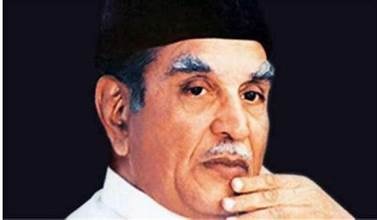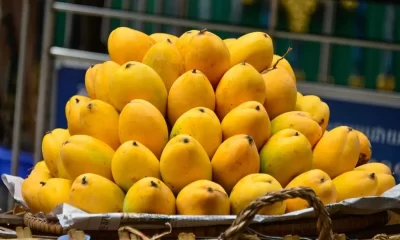Article
Hakim Mohammed Saeed: A Visionary Scholar and Humanitarian( 9 Jan 1920 – 17 Oct 1998)
Published
7 months agoon
By
EDITOR
Hakim Mohammed Saeed was one of Pakistan’s most respected scholars, philanthropists, and leaders in the field of natural medicine. His contributions as a pioneer in herbal medicine, an educationist, and a philanthropist have left an indelible mark on Pakistan’s social, educational, and medical landscapes. Throughout his life, he remained committed to the welfare of the people, earning him immense respect and admiration.
Early Life and Education
Born on January 9, 1920, in Delhi, India, Hakim Mohammed Saeed hailed from a family deeply rooted in the tradition of herbal medicine. His father, Hakim Abdul Majeed, was the founder of Hamdard Dawakhana, an institution dedicated to traditional medicine, especially Unani herbal medicine. Saeed inherited this legacy and continued to strengthen it throughout his life.
He completed his early education in Delhi and pursued higher studies in Unani medicine. After migrating to Pakistan following the partition of India in 1947, Saeed laid the foundation of Hamdard Pakistan, a continuation of his family’s work in traditional medicine.
Hamdard Pakistan and Contributions to Herbal Medicine
Upon arriving in Pakistan, Hakim Saeed established Hamdard Laboratories in Karachi in 1948. Under his leadership, Hamdard became a leading name in herbal medicine, producing quality natural remedies that are still widely used today. His commitment to Unani medicine not only preserved a critical part of South Asian medical history but also provided a natural alternative to Western pharmaceuticals.
Hamdard expanded its product line and research capacity over the years, contributing to Pakistan’s pharmaceutical industry. Saeed was known for his strict adherence to quality and integrity, ensuring that Hamdard remained a trusted name in herbal medicine.
Educational and Research Initiatives
Hakim Mohammed Saeed believed that education and research were the cornerstones of national progress. In 1985, he founded Hamdard University, one of Pakistan’s most prestigious private institutions. The university offers a wide range of disciplines, including medicine, law, engineering, and humanities, and it continues to be a center of learning and research in Pakistan. Through Hamdard University, Saeed aimed to foster intellectual growth and critical thinking among students, equipping them with the tools necessary for national development.
Additionally, Saeed established Madinat al-Hikmah, a city of education, science, and culture that includes Hamdard University, the Hamdard Village School, and Bait al-Hikmah (the House of Wisdom), a library containing an extensive collection of books and manuscripts. These initiatives reflect his deep commitment to learning and his vision of a self-reliant Pakistan through education.
Philanthropy and Social Services
Hakim Saeed’s philanthropy was boundless, and his efforts in the service of humanity extended beyond the field of medicine. He dedicated much of his life to addressing social issues such as poverty, healthcare, and education. His work was not limited to Pakistan; he also supported various international organizations and causes that aligned with his vision of peace, health, and education for all.
His weekly free clinics provided healthcare to thousands of underprivileged citizens. He emphasized preventive healthcare and the importance of natural treatments, and his clinics were a source of relief for many who could not afford modern treatments.
Role as Governor of Sindh
Hakim Mohammed Saeed’s selfless service to the nation was recognized when he was appointed as the Governor of Sindh in 1993. Although his tenure was brief (from 1993 to 1994), he used this position to promote his ideals of education, health, and social welfare. Even in this role, his humility and commitment to the people never wavered. He frequently interacted with the public and continued his philanthropic activities.
Assassination and Legacy
On October 17, 1998, Pakistan lost one of its most beloved figures when Hakim Mohammed Saeed was tragically assassinated in Karachi. His death shocked the nation, and his absence was deeply felt by those who had benefited from his generosity and wisdom.
Despite his untimely death, Hakim Saeed’s legacy endures. His contributions to herbal medicine, education, and philanthropy remain an integral part of Pakistan’s development. Institutions like Hamdard Laboratories and Hamdard University continue to thrive, carrying forward his vision of serving humanity. His writings, which span over 200 books on topics ranging from medicine to Islamic thought and education, continue to inspire generations.
You may like
-


The Chiltan Ibex: A Rare Treasure of Balochistan
-


MANGO HEALTH BENEFITS NUTRITION
-


“Rising above the rugged terrain of Balochistan, Koh-i-Chiltan stands as a symbol of mystery and resilience.”
-


Aik Qaum, Aik Sath | Pakistan Zindabad | Pakistan Day Song | 23rd March 2024 | AIKQAUM.COM
-


Nation celebrates Pakistan Day today with traditional zeal
-


Pakistan Day: A Reminiscence of the Heroic Struggle of Muslims of the Subcontinent
Article
The Chiltan Ibex: A Rare Treasure of Balochistan
Published
1 month agoon
April 16, 2025By
EDITOR
The Chiltan ibex (Capra aegagrus chiltanensis), a subspecies of the wild goat, is one of the most unique and endangered animals native to Pakistan. Found exclusively in the rocky highlands of the Chiltan range within the Hazarganji-Chiltan National Park in Balochistan, this elusive animal represents the region’s rich biodiversity and ecological heritage.
Physical Characteristics
The Chiltan ibex is a strikingly beautiful species, with a robust, muscular build perfectly suited for navigating steep and rocky terrains. Males are particularly distinctive, boasting impressive curved horns that can grow up to 30 inches (76 cm) in length. Their coat is light brown, with a darker stripe running along their back and legs, providing excellent camouflage in their arid mountainous habitat.
Females are smaller in size with shorter, more slender horns, and their coloration is less pronounced, blending seamlessly into their surroundings. This camouflage helps protect them and their offspring from predators such as wolves and large birds of prey.
Habitat and Range
The Chiltan ibex inhabits the rugged, semi-arid regions of the Chiltan range, located within the Hazarganji-Chiltan National Park, southwest of Quetta. These high-altitude areas, ranging from 1,500 to 3,200 meters above sea level, are characterized by rocky cliffs, sparse vegetation, and extreme weather conditions.
The ibex is well-adapted to this challenging environment, where it feeds on grasses, shrubs, and the leaves of juniper trees. Its ability to climb steep slopes and jump across narrow ledges gives it a unique advantage in escaping predators and surviving in such inhospitable terrain.
Behavior and Social Structure
Chiltan ibexes are diurnal, meaning they are active during the day. They are typically found in small groups, with herds consisting of females and their young. Males are more solitary, joining herds only during the breeding season, which occurs in the late autumn and winter months.
During this time, males engage in dramatic displays of strength to compete for mating rights, including horn clashing and dominance rituals. After a gestation period of around six months, females give birth to one or two kids in spring, when food availability is higher.
Conservation Status
The Chiltan ibex is classified as endangered due to its restricted range, habitat loss, and poaching. Habitat degradation caused by overgrazing, deforestation, and human encroachment poses significant threats to its survival.
Historically, the ibex faced heavy hunting pressure for its horns, considered a symbol of prestige, and for its meat. Although hunting is now banned in the national park, illegal poaching remains a concern.
Conservation Efforts
To protect the Chiltan ibex and its fragile ecosystem, the Hazarganji-Chiltan National Park was established in 1980. Spanning over 32,500 acres, the park provides a safe haven for the ibex and other wildlife, such as wolves, foxes, and birds of prey.
Conservation efforts include:
- Anti-Poaching Measures: Increased patrolling and strict enforcement of hunting bans have helped reduce poaching incidents.
- Habitat Restoration: Programs to control overgrazing and reforest juniper woodlands are underway to restore the ibex’s natural habitat.
- Public Awareness Campaigns: Local communities are being educated about the importance of biodiversity and the role of the Chiltan ibex in maintaining ecological balance.
- Eco-Tourism Initiatives: Promoting responsible tourism generates revenue for conservation projects and raises awareness about the ibex’s plight.
Ecological Importance
The Chiltan ibex plays a vital role in its ecosystem as both a grazer and prey species. By feeding on shrubs and grasses, it helps maintain vegetation balance, preventing overgrowth and contributing to soil health. At the same time, it serves as a food source for predators, sustaining the natural food chain.
Protecting the ibex is not just about saving a single species—it’s about preserving an entire ecosystem that supports numerous forms of life, from tiny insects to apex predators.
Cultural Significance
For the people of Balochistan, the Chiltan ibex is more than just a wild animal; it is a symbol of the region’s natural beauty and resilience. Local folklore often intertwines with the ibex, celebrating its agility and strength. The species also draws international attention, making it a flagship for wildlife conservation in Pakistan.
The Future of the Chiltan Ibex
While conservation efforts have shown promise, the Chiltan ibex remains vulnerable. Protecting this rare species requires continued collaboration between government agencies, conservation organizations, and local communities.
By safeguarding the Chiltan ibex, we not only preserve a unique animal but also protect the fragile ecosystem of Balochistan, ensuring that future generations can marvel at the beauty and resilience of this incredible species.
The Chiltan ibex is a testament to nature’s ability to adapt and survive in the harshest of environments. As efforts to protect it continue, this majestic animal stands as a beacon of hope for wildlife conservation in Pakistan.
Article
“Rising above the rugged terrain of Balochistan, Koh-i-Chiltan stands as a symbol of mystery and resilience.”
Published
1 month agoon
April 16, 2025By
EDITOR
Koh-i-Chiltan, located in the rugged terrain of Balochistan, Pakistan, is not just a striking natural feature but also a site steeped in folklore, mysticism, and ecological significance. Rising to a height of approximately 3,194 meters (10,479 feet), it is the third-highest peak in the Chiltan range, forming part of the Sulaiman Mountain system. The mountain holds a commanding presence in the landscape and attracts mountaineers, nature lovers, and those intrigued by its legends.
Geography and Location
Koh-i-Chiltan is situated within the Hazarganji-Chiltan National Park, about 20 kilometers southwest of Quetta, the provincial capital of Balochistan. The name “Koh-i-Chiltan” translates to “The Mountain of Forty Spirits,” derived from local folklore that has become intertwined with its identity.
The surrounding park, spread across 32,500 acres, is a semi-arid region characterized by rugged cliffs, deep ravines, and sparse vegetation. The area is home to a diverse ecosystem, ranging from juniper forests to an array of fauna, including the Chiltan markhor, a rare wild goat species named after the mountain.
The Legend of the Forty Spirits
The legend of Koh-i-Chiltan is one of the most captivating tales of the region. According to local folklore, the mountain is haunted by the spirits of forty abandoned children. The story goes that a couple, unable to have children, sought help from a mystic who blessed them with forty babies. Overwhelmed by the burden of raising so many children, the couple is said to have abandoned them on the mountain.
The children, according to the legend, were nurtured by the mountain itself and eventually transformed into spirits. Locals believe these spirits still guard the mountain, and stories abound of mysterious voices, sightings, and unexplainable phenomena experienced by those who venture into the area.
This haunting narrative has contributed to the mountain’s mystique, drawing spiritual seekers and adventurers alike to experience its enigmatic aura.
Ecological Importance
Koh-i-Chiltan is not just a place of legends but also a significant ecological zone. The mountain and its surrounding national park serve as a critical habitat for the endangered Chiltan markhor, which is endemic to the region. Efforts to conserve this species have made the mountain a focal point for environmentalists and wildlife researchers.
The park also hosts other wildlife, including wolves, hyenas, foxes, and various bird species, making it a biodiversity hotspot. The juniper forests in the region are among the oldest in the world, some dating back several thousand years, and play a vital role in maintaining the ecological balance of the arid environment.
Tourism and Adventure
Koh-i-Chiltan is a growing destination for eco-tourism and adventure enthusiasts. Trekkers and climbers are drawn to the mountain’s challenging trails, which offer panoramic views of the surrounding landscapes. The Hazarganji-Chiltan National Park provides additional opportunities for hiking, wildlife observation, and photography.
Visitors to the mountain often report an eerie silence and a sense of being watched, experiences that only add to the allure of exploring Koh-i-Chiltan. Those interested in local culture and history will find the legends and traditions associated with the mountain as compelling as its natural beauty.
Cultural Significance
For the people of Balochistan, Koh-i-Chiltan holds cultural and spiritual importance. The mountain is a symbol of resilience and mystery, reflecting the character of the region itself. Local festivals and storytelling often feature the legend of the forty spirits, preserving the mountain’s legacy in the collective memory of the community.
Challenges and Conservation Efforts
Despite its significance, Koh-i-Chiltan faces challenges such as deforestation, overgrazing, and climate change. Conservation efforts, led by both government and non-governmental organizations, aim to protect the mountain’s delicate ecosystem. Initiatives include reforestation programs, wildlife monitoring, and community engagement to promote sustainable tourism.
Article
Aik Qaum: The Fusion of Integrity and Patriotism
Published
2 months agoon
March 19, 2025By
EDITOR
We keep Integrity closest to our Heart and Patriotism on top of our mind.
Integrity and patriotism are not separate entities; they are intertwined in the soul of Pakistan. The people understand that to be a patriot is to uphold the principles of integrity. Honesty and love for one’s country are two sides of the same coin. Together, these values form the essence of “Aik Qaum.”
The fusion of integrity and patriotism is evident in the everyday lives of Pakistanis. It’s in the farmer toiling the fields, the teacher educating the youth, and the soldier guarding the borders. It’s in the child who dreams of a better Pakistan and the elderly who have seen the nation grow. “Aik Qaum” is the realization that integrity and patriotism are the heart and mind of Pakistan, beating in unison to guide the nation forward.
As we celebrate the spirit of “Aik Qaum,” we honor the values that make Pakistan a unique and resilient nation. Integrity and patriotism serve as our guiding stars, leading us towards a brighter and more prosperous future. In the heart of every Pakistani and at the forefront of their minds, “Aik Qaum” stands as a testament to the strength of a united nation, bound by the principles of integrity and the unyielding love for their homeland.
In Pakistan, “Aik Qaum” is not just a motto; it’s a way of life that embodies the enduring spirit of a proud and united nation.

The Chiltan Ibex: A Rare Treasure of Balochistan

MANGO HEALTH BENEFITS NUTRITION








